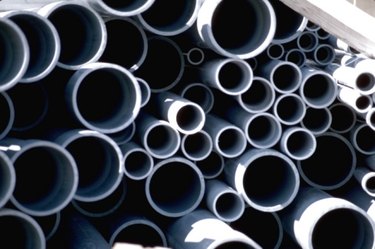
The sewer drain system in your home takes used water and other waste material from your appliances to your home's main sewer drain and then out to your town's sewage system. Whether you flush a toilet, drain your bathtub or rinse clothes in your washing machine, all the drained liquid ends up in the same place.
However, that doesn't mean that you can use the same-size PVC pipes for all your sewer drains. Different types of drains require different sizes, and deviating from those sizes can do much more harm than good. The size of PVC pipe you should use for a drain will depend on where you're using it in your plumbing. Main sewer lines need to be at least 4 inches in diameter, but other drains will have smaller pipes.
Video of the Day
Video of the Day
Standard PVC Pipe Sizes for Household Drains
The most common standard sizes for PVC sewer pipes are pretty consistent in most homes. However, if you're in the process of installing a new appliance or fixing an issue with existing lines, the best rule of thumb is to go with the size currently installed. If you think you have the wrong size of PVC pipe for your sewer drain, consult a plumber or contractor to ensure the issue gets resolved.
Especially in a recently built or renovated home, sewer pipe systems will almost always consist of the same sizes. These sizes are measured in diameter. The diameter is the distance from one point on the circle to the exact opposite side of the circle, which should be twice the radius.
The standard size for a sewer drain leading away from a toilet is 3 inches in diameter. That's on the larger side of sewer drains, and it's easy to understand why: Toilet drains must accommodate both paper and human waste solids.
Other Types of Drains
The drains in your bathroom from the bathtub or shower and sinks are typically 1.5 inches in diameter, although some bathtubs and showers might have 2-inch drainpipes. Other than some hair, dirt, soap scum and other small matter, relatively little material gets washed down your bathroom drains, and your kitchen drain should have an assist from the garbage disposal. However, this smaller size is why they sometimes clog more quickly than others.
Washing machine and laundry sink drains are usually larger than bathroom drains, but they are still smaller than toilets. Any sewer pipes leading from the laundry room are typically 2 inches in diameter.
Your home's main sewer drain takes the wastewater and other matter away from each individual drain to the main sewer that runs underground in your neighborhood. It is usually 4 inches in diameter to ensure that it is large enough to deal with most anything that could be in it.
Can You Fix a Chronic Clog With a Bigger Pipe?
The larger the sewer pipe, the more matter can make its way through the drainage system at one time. Because of that, you might be tempted to install a larger PVC pipe on a drain that clogs frequently. After all, it makes sense logically.
However, doing so can cause other problems, and most experts strongly recommend against it. You have to consider water pressure. For example, the pressure in a bathroom sink drain with a 2-inch drainpipe won't be strong enough to force the water all the way through. As a result, your wastewater might sit in the pipe and start to smell or even back up.
If a drain in your house frequently clogs and less-drastic remedies, like drain cleaner, don't work well, replace the drainpipes with the same size of pipes you currently have. If that doesn't work, try examining your behavior and how you use it to see if it's something you're doing wrong. If you can't identify anything, it might be time to call in a plumber.